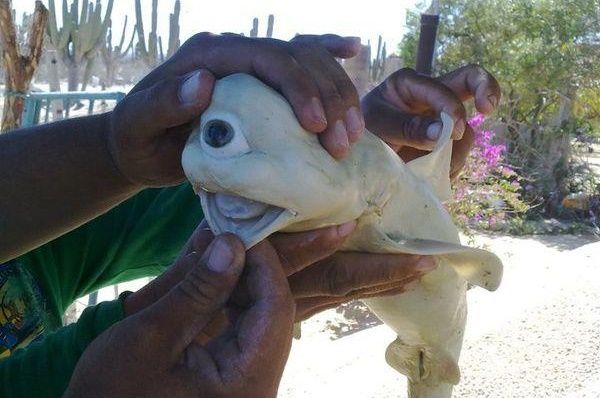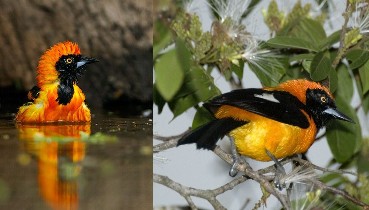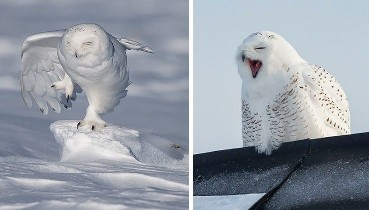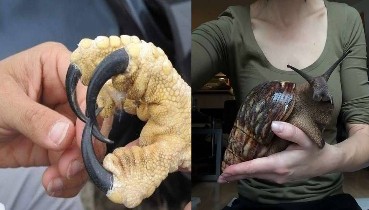

Pictures: Rare “Cyclops” Shark Found

One-Eyed Anomaly
Photograph courtesy Marcela Bejarano-Álvarez
Talk about a one-of-a-kind discovery—an extremely rare cyclops shark (pictured) has been confirmed in Mexico, new research shows.
The 22-inch-long (56-centimeter-long) fetus has a single, functioning eye at the front of its head—the hallmark of a congenital condition called cyclopia, which occurs in several animal species, including humans.Earlier this year fisher Enrique Lucero León legally caught a pregnant dusky shark near Cerralvo Island (see map) in the Gulf of California. When León cut open his catch, he found the odd-looking male embryo along with its nine normal siblings. “He said, That’s incredible—wow,” said biologist Felipe Galván-Magaña, of the Interdisciplinary Center of Marine Sciences in La Paz, Mexico.
Once Galván-Magaña and colleague Marcela Bejarano-Álvarez heard about the discovery—which was put on Facebook—the team got León’s permission to borrow the shark for research. The scientists then x-rayed the fetus and reviewed previous research on cyclopia in other species to confirm that the find is indeed a cyclops shark.
Cyclops sharks have been documented by scientists a few times before, also as embryos, said Jim Gelsleichter, a shark biologist at the University of North Florida in Jacksonville. The fact that none have been caught outside the womb suggests cyclops sharks don’t survive long in the wild.
Overall, finding such an unusual animal reinforces that scientists still have a lot to learn, Gelsleichter added.


The Eye Has It
Photograph courtesy Marcela Bejarano-Álvarez
The cyclops shark also has other deformities, including albinism, or a total lack of tissue pigments; no nostrils; a bump on its snout; and a spinal abnormality, according to Galván-Magaña. (See more pictures of albino animals.)
A mother’s poor diet—especially a lack of vitamin A—can cause cyclopia in mammals, including people, but it’s difficult to determine the cause of the condition in sharks, he said.
Even so, Galván-Magaña suspects the defects in this case aren’t related to pollution. “The fishing area close to Baja California Sur is clear of pollution, is a pristine zone, and we cannot consider it as a cause for abnormalities in dusky sharks,” according to the study.

Stand-Out Shark
Photograph courtesy Marcela Bejarano-Álvarez
If it’d been born, the cyclops shark (pictured) likely wouldn’t have lived very long, Galván-Magaña said.
The baby’s stark white color would’ve made it more obvious to predators, and its malformed tail would’ve hindered swimming.
Aside from the handful of deformities, “the rest of the body was apparently normal,” with well-formed fins, according to the scientists’ study, which has been submitted for publication.

Black Sheep of the Family
Photograph courtesy Enrique Lucero León
The cyclops shark is pictured next to one of its siblings, which is normally colored, with a blue-gray back and white underside.
Dusky sharks, which average about 10 feet (3 meters) long as adults, are among the slowest growing of the shark species and can live for up to 45 years.
Often illegally harvested for its fins, the shark species is considered vulnerable by the International Union for Conservation of Nature.

Oddball Shark
Photograph courtesy Enrique Lucero León
Above, the albino cyclops shark lies among other captured sharks. In addition to the one eye, albinism is a rare condition among sharks, occurring more often in bony fishes, Galván-Magaña said.
There are no previous known cases of albino dusky sharks, “so this report is considered a first record of this malformation for this shark species in Mexico,” according to the study.
Recommended Videos
 Orange Backed Troupial204 views
Orange Backed Troupial204 views Rare “Fire Rainbow” Appears In Sky Over South Carolina86 views
Rare “Fire Rainbow” Appears In Sky Over South Carolina86 views-
Advertisements
 50 Times People Ruined A Perfectly Good Panoramic Shot710 views
50 Times People Ruined A Perfectly Good Panoramic Shot710 views Perfectly Timed Photos Of Owls Are Hilarious Yet Awkward (7 Pics)1994 views
Perfectly Timed Photos Of Owls Are Hilarious Yet Awkward (7 Pics)1994 views 25 Breathtaking Winning Photos From The “Northern Lights Photographer Of The Year”274 views
25 Breathtaking Winning Photos From The “Northern Lights Photographer Of The Year”274 views 49 Absolutely Terrific Images From The Past That Are Just Amazeballs4314 views
49 Absolutely Terrific Images From The Past That Are Just Amazeballs4314 views 25 Horrible Design Fails That Will Leave You Speechless8765 views
25 Horrible Design Fails That Will Leave You Speechless8765 views Valentine’s Day Roses48 views
Valentine’s Day Roses48 views



